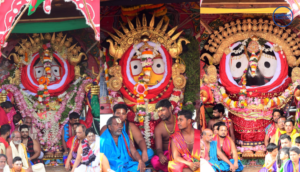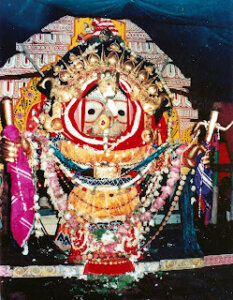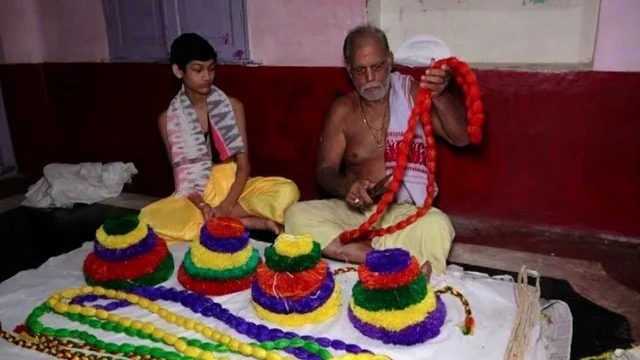Rakhi Purnima, also known as Gamha Purnima, is celebrated with passion throughout Odisha. The holiday honors the bond between brothers and sisters.
Every family begins festival preparations early in the morning, with brothers and sisters leading the way. Boys are completely prepared with gifts for their cherished sisters, while females prepare the “puja thali” with colorful “rakhis” as well as chandan-tilak, sindoor (vermilion), akshat (rice), lamps, and sweets. Girls put tilak on their foreheads and wrists and attach rakhi threads after performing ‘aarti’ for the safety of their brothers. In exchange, the sisters receive gifts from their brothers as a token of their affection, and they agree to keep an eye out for them.
By tying a rakhi, any male can be “adopted” as a brother, whether they are relatives or close acquaintances. Several socio-cultural organizations also observe it in order to promote fraternity. Rakhi does not have to be given only to biological brothers.

HISTORY
The Rakhi Festival is both mythological and historical in nature.Mahabharatha is one of the greatest epics of all time and all ages. Rakhi celebrations begin with the tie between Draupadi and Krishna.Sharavana was the month. Along with the Pandavas, Krishna and Draupadi were having a fantastic time. During this time, Krishna cut his finger and began bleeding. While everyone else was running around looking for something to stop the bleeding, Draupadi tore the end of her sari and tied it to the wound. Krishna pledged to guard her forever in exchange for the same. The event is thought to be the first symbolic Rakhi ceremony.
Birth ceremony of Lord Balabhadra considered the Lord of farmers – the rituals at Srimandir.

Rakhi Purnima is performed with all rituals in Odisha at the Lord Jagannath Temple in the pilgrimage city of Puri on the auspicious festival of Gamha Purnima, which is Lord Balabhadra’s or Balaram’s birthday.
Lord Balaram was born on the Shravan nakshatra’s “Gamha Purnami on Makara Lagna”. As a result, He is the creator of agriculture and the Lord of the farms. As a result, peasant families customarily venerate their wooden ploughs. ‘Gamha’ is most likely a derivation of the term ‘Go-mata. Lord Balaram was created from a cow named Rohini, according to the Harivamsa. As a result, he is intimately tied to cow herds. Rakhis are tied to the horns of cattle on this day, and the animals are decorated with garlands. The animals are fed a variety of delicacies and pancakes.
Lord Baladeva’s birthday is celebrated in Odisha, particularly in Paralakhemundi, Nayagarh, Brahmapur, and other locations, by playing the popular game known as Gamha-Diyan (the Gamha Jump). It is an essential component of Odisha’s martial tradition. The Paikas believed that this day was the most favourable for starting the new combat techniques.
Despite the fact that Lord Jagannath, together with his siblings Lord Balabhadra and Devi Subhadra, are worshiped as Daru-Brahma at Srimandir Puri, He observes festivals and follows all rites exactly like any other individual. Lord Balabhadra and Lord Jagannath get rakhi from their sister Devi Subhadra, who also wears one.
On this important day, members of the Patara Bisoi servitors perform four rakhis. The rakhi of Lord Jagannath is red and yellow, whereas Lord Balabhadra’s is blue and violet.
On the day of Gamha Purnima, Lord Balabhadra’s birth is commemorated in Srimandir. Ratnabedi’s six gold-encrusted idols are Lord Jagannath, Balabhadra, Subhadra, Sudarshan, Bhudebi, and Sridebi.
The Sudha Suar servitors prepare for puja with the help of Puja Panda, Pati Mohapatra, and Mudirasta. Madan Mohan, the envoy of Lord Jagannath, Balabhadra, and Subhadra, is offered the order of Lord Jagannath (Angyamala) for the Jhulana ceremonies (the swing rituals). Sudarshan then exits his seat and boards the “Chaudola” known as “Harida Mali,” which is decked with golden garlands.
The deity then proceeds to Markandeya Pond. Sudha Suara conducts many ceremonies while making the image of Lord Balabhadra out of wet clay.
The mantras uttered by the Puja Panda bring the idol to life. Bhoga is offered to the idol there. The idol is then thrown into the pond. Lord Sudarshan returns to Srimandir late after the idol is immersed in the night.
The story behind how was Balarama born-
Balarama Jayanti commemorates the birth of Lord Balarama, Lord Krishna’s elder brother.
Lord Balarama was Devaki and Vasudeva’s seventh child. After Kamsa slaughtered all of Devaki’s children, an unborn Balarama was moved to the womb of Rohini, Vasudeva’s other wife. Balarama was thus born as Rohini’s son.
On this day, special functions and prayers are presented to the Lord all around the world. Lord Balarama represents both spiritual strength and pleasure.
Because He was taken away from Devaki’s womb and into Rohini’s, He was given the name Sankarshana (one who was dragged away).
Another theory exists regarding the origin of Balarama. He was the second incarnation of the huge serpent Seshanag, and when He died, the serpent is reported to have erupted from his lips.
Sri Krishna’s eternal companion is Lord Balarama. He appeared as Lakshmana with Rama in Satya Yug and then as Nityananda Prabhu with Chaitanya Mahaprabhu in Kali Yug.







 Finance
Finance







